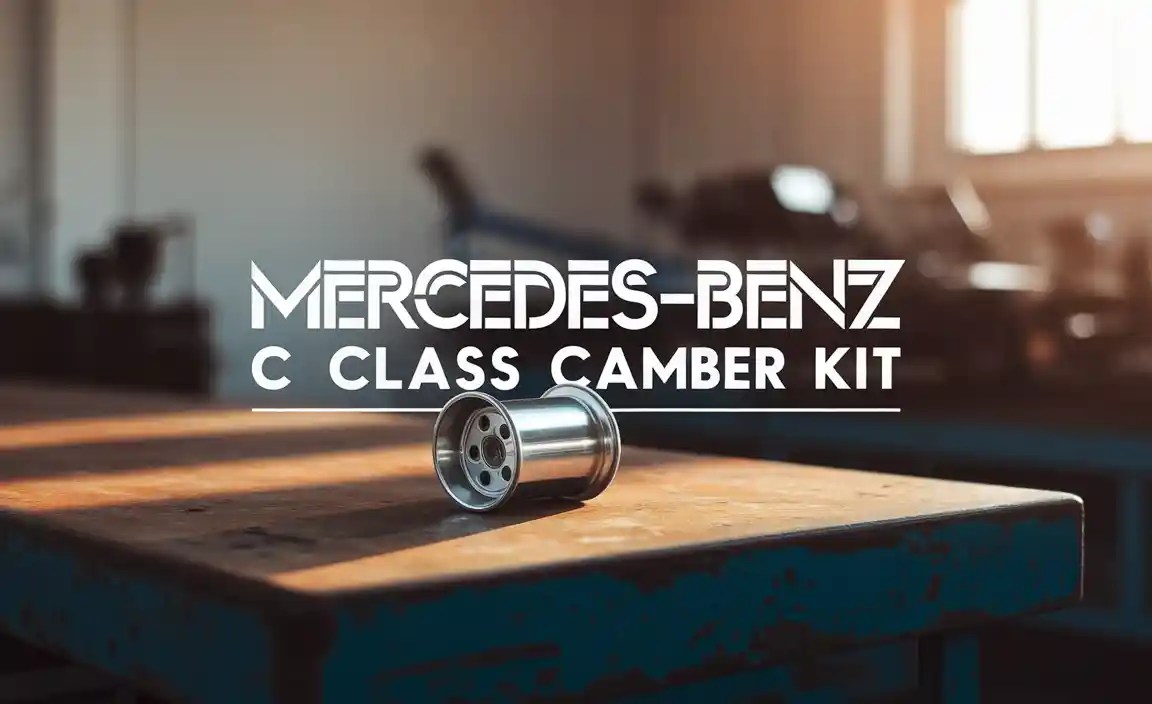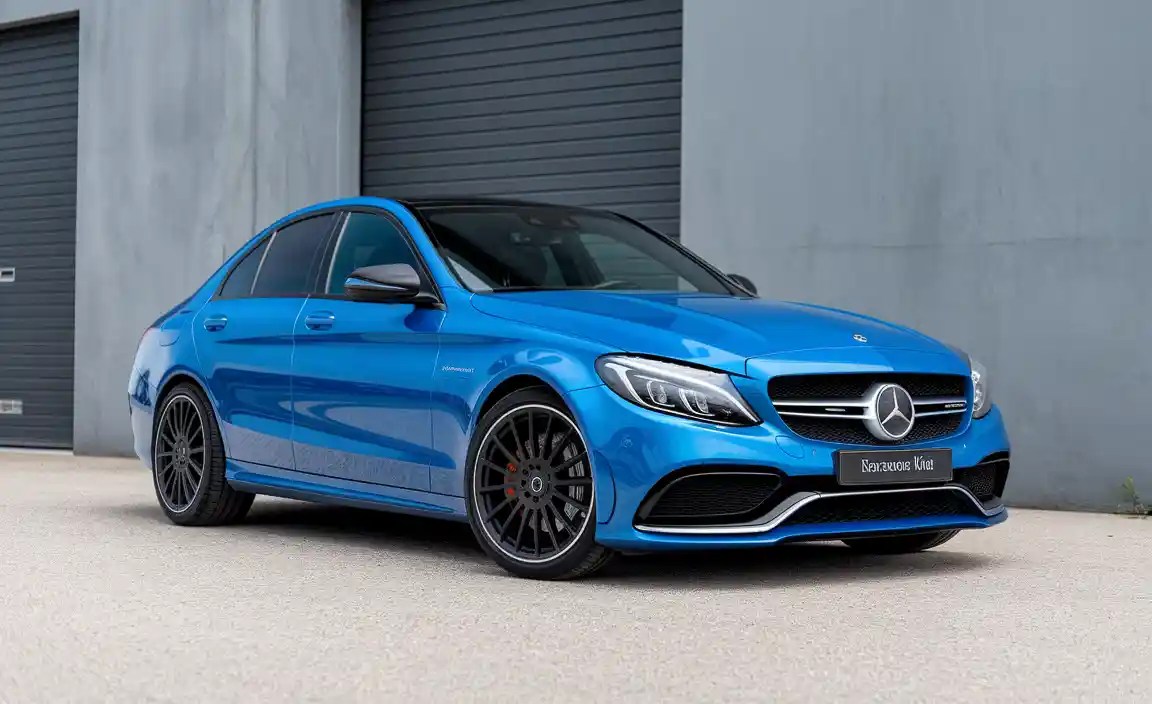Mercedes-Benz C Class Camber Kit: Ultimate Driving Perfection
A C-Class camber kit allows for precise adjustment of wheel angle, enhancing grip, tire wear, and overall handling for a superior driving experience. It’s a valuable upgrade for enthusiasts seeking peak performance and a more connected feel to the road.
Is your Mercedes-Benz C-Class feeling a little less precise than it used to? Perhaps you’ve upgraded your suspension or noticed uneven tire wear, and the steering doesn’t feel quite “right” anymore. These are common signs that your wheel alignment, specifically the camber angle, might be off. Fortunately, addressing this is often simpler than you think, and the result can be a dramatic improvement in your car’s handling. We’re here to guide you through understanding and upgrading your C-Class with a camber kit, ensuring you get that ultimate driving perfection.
This guide will break down what a camber kit is, why your C-Class might need one, and how it can transform your driving experience. We’ll cover the benefits, the installation process, and what to expect. Get ready to unlock a new level of performance from your beloved Mercedes.

Understanding Wheel Alignment: What is Camber?

Before we dive into camber kits, let’s ensure we’re all on the same page regarding wheel alignment. A car’s suspension is a complex system, and the angles at which your wheels sit relative to the road surface are critical for stability, handling, and tire longevity. Three key alignment angles are typically adjusted:
- Camber: This refers to the inward or outward tilt of the top of the tire when viewed from the front of the vehicle.
- Caster: This is the angle of the steering axis when viewed from the side of the car.
- Toe: This describes the inward or outward angle of the tires when viewed from above, similar to looking down at your feet.
For this discussion, we’re focusing on camber. When a car is perfectly upright, it has zero camber. If the top of the tire tilts outward, it’s positive camber. If the top tilts inward, it’s negative camber. Most production cars are designed with slight negative camber for optimal cornering grip, but this can be compromised by modifications, wear, or even just the vehicle’s natural settling over time.
Why Your C-Class Might Need a Camber Kit
Your Mercedes-Benz C-Class is engineered for a refined and dynamic driving experience. However, several factors can necessitate a camber adjustment beyond factory specifications, often best achieved with a dedicated camber kit. These reasons typically fall into a few categories:
1. Aftermarket Suspension Upgrades
If you’ve lowered your C-Class with performance springs or coilovers, you’ve likely experienced a significant change in its stance. Lowering a vehicle inherently alters its suspension geometry, often leading to increased negative camber. While some negative camber can be beneficial for cornering, too much can result in:
- Excessive Inner Tire Wear: The inside edge of your tires will wear down much faster than the rest of the tread.
- Reduced Straight-Line Stability: The car might feel “darty” or less stable at higher speeds.
- Compromised Handling Feel: The steering might feel heavy, or the car may understeer (push wide) more in corners.
A camber kit allows you to dial in the camber angle precisely, negating these negative effects and restoring optimal handling characteristics to your lowered C-Class.
2. Uneven Tire Wear
Observing uneven wear patterns on your tires is a clear indicator of an alignment issue. If the inner or outer edges of your tires are significantly more worn than the tread in the center, camber is often the culprit. This not only shortens the lifespan of your expensive tires but also compromises grip and safety.
3. Desire for Enhanced Performance
Even if your C-Class is stock, enthusiasts often seek to optimize its handling for spirited driving or track use. Increasing negative camber slightly can significantly improve cornering grip. By tilting the tires inward at the top, the tire maintains a flatter, more consistent contact patch with the road during a turn, even when the body rolls outward. A C-Class camber kit provides the adjustability to achieve this optimal performance setup.
4. Correcting Alignment After Accidents or Wear
Minor impacts or simply the cumulative effect of miles and road imperfections can subtly shift suspension components. In some cases, factory alignment adjustments may not be sufficient to bring the camber back within the ideal range, especially if the chassis has experienced any stress. A camber kit offers the extra range needed for precise correction.
What is a C-Class Camber Kit?

At its core, a camber kit is a set of modified suspension components designed to allow for adjustments to the wheel’s camber angle that are not possible with the factory-fitted parts. These kits replace or augment specific stock components, typically:
- Adjustable Control Arms: These are the most common type of camber kit. They replace the fixed-position factory control arms with units that feature eccentric (off-center) bolts or slotted mounting points. By rotating the eccentric bolt or sliding the arm within its mounting, you can significantly alter the arm’s effective length or pivot point, thus changing the camber angle.
- Top Mounts/Strut Mounts: For MacPherson strut suspensions (common on many C-Class models), adjustable top mounts can be used. These replace the fixed strut towers with units that allow the top of the strut to be moved fore and aft, which in turn adjusts camber.
These kits are specifically engineered for your C-Class model and suspension type, ensuring proper fitment and the ability to achieve the desired alignment range.
The Benefits of Installing a C-Class Camber Kit
Investing in a quality camber kit for your Mercedes-Benz C-Class can yield significant improvements in several key areas:
Enhanced Cornering Performance
This is often the primary reason enthusiasts opt for a camber kit. By allowing for more negative camber, the tire can maintain a flatter contact patch with the road during hard cornering. This translates to:
- Increased Grip: The tire is less likely to lose traction, allowing for higher cornering speeds.
- Improved Steering Response: The car feels more planted and responsive to steering inputs.
- Reduced Body Roll: While not its primary function, proper camber adjustment contributes to a more stable feeling in turns.
Reduced and Even Tire Wear
One of the most practical benefits is correcting uneven tire wear. By adjusting camber to a more neutral position or a specific setting optimized for your driving style and suspension height, you can ensure your tires wear evenly across the tread. This:
- Extends Tire Life: Maximizing the lifespan of your tires saves money.
- Improves Traction: Evenly worn tires provide more consistent grip.
- Reduces Vibrations: Unevenly worn tires can cause noticeable vibrations.
Customizable Handling Characteristics
A camber kit gives you the flexibility to fine-tune your C-Class’s handling. Whether you’re setting up for a track day, autocross event, or simply want a more engaging street driving feel, you can adjust camber to suit your needs. For example:
- Street Driving: A slight negative camber might be ideal for a good balance of comfort and cornering ability.
- Track Use: More aggressive negative camber can be dialed in to maximize grip during high-speed cornering.
Restoring Proper Alignment
After significant suspension work, accidents, or simply due to age and wear, the factory alignment adjustments can be insufficient. A camber kit provides the necessary range to bring your alignment back into the optimal specifications for safe and predictable driving.
Types of C-Class Camber Kits: Front vs. Rear

Mercedes-Benz C-Class models can differ in their suspension setups, and therefore, the type of camber kit required can vary. It’s crucial to identify which end of your car requires adjustment.
Front Camber Kits
Most C-Class vehicles feature a double-wishbone or multi-link front suspension. For these setups, camber is typically adjusted via either the upper or lower control arms. Front camber kits usually consist of:
- Adjustable Control Arms: These replace the stock arms and incorporate eccentric adjusters or slotted mounting holes.
- Adjustable Ball Joints or Tie Rod Ends: Less common for camber adjustment alone, but sometimes part of a broader alignment kit.
Adjusting front camber significantly impacts steering feel, stability, and how the car behaves under braking and cornering. It’s often the first adjustment made when seeking to optimize handling.
Rear Camber Kits
The rear suspension on C-Class models is typically a multi-link design. These systems often have more points of adjustment, but factory range can still be limited, especially after lowering. Rear camber kits commonly involve:
- Adjustable Rear Control Arms (Upper/Lower): Similar to front kits, these replace stock arms with adjustable versions.
- Adjustable Toe Links: While primarily for toe adjustment, some kits may offer combined functionality or be used in conjunction with camber adjustment.
Rear camber adjustment is critical for stability during acceleration and cornering, and it’s a major factor in managing tire wear across the rear axle.
Key Considerations When Choosing a C-Class Camber Kit
Not all camber kits are created equal, and selecting the right one for your C-Class involves careful consideration of a few factors:
Vehicle Model and Year
Crucially important: Ensure the kit is specifically designed for your exact Mercedes-Benz C-Class model (e.g., W204, W205, W206) and year. Suspension mounting points and designs vary significantly between generations.
Adjustment Range
Consider how much adjustment capability you need. If you’ve only lowered your car a modest amount, a kit with a moderate adjustment range will suffice. For significant lowering or aggressive performance setups, you’ll need a kit with a broader range of adjustability. Manufacturers usually specify the degree of adjustment achievable.
Build Quality and Materials
Look for kits made from high-quality materials. Forged steel or aluminum arms are preferable, and the pivot points should feature durable bushings (e.g., performance rubber, polyurethane, or spherical bearings) designed to withstand the stresses of performance driving. Reputable brands often use premium components to ensure longevity and consistent performance.
Ease of Adjustment
Some kits are easier to adjust than others. Eccentric bolt systems are generally straightforward, while some multi-link designs might require more intricate adjustments. Read reviews and consider how the adjustment mechanism works.
Brand Reputation and Reviews
Stick with well-known and respected brands in the automotive aftermarket. Look for reviews from other Mercedes-Benz owners who have used the specific kit on a similar model. Real-world feedback can highlight potential issues or confirm excellent performance.
Budget
Camber kits can range in price. While it’s tempting to go for the cheapest option, investing in a quality kit from a reputable manufacturer will likely save you money in the long run through durability and precise performance. Expect to pay anywhere from $150 to $500+ for a quality set.
Examples of Reputable Brands (General Automotive Aftermarket):
- SPC (Specialty Products Company)
- Eibach
- H&R
- Whiteline
- Megan Racing
Always verify compatibility for your specific C-Class generation.
Installation Process: A Step-by-Step Overview
Installing a C-Class camber kit is a job that typically requires mechanical skill and specialized tools. If you’re not comfortable with suspension work, it’s highly recommended to have a qualified professional perform the installation and alignment. However, understanding the process can be very helpful.
Tools You’ll Likely Need:
- Jack and jack stands
- Socket set and wrenches (metric)
- Torque wrench
- Pry bars
- Alignment rack or measuring tools
- Possibly a spring compressor (if dealing with struts)
- Penetrating oil (for stubborn bolts)
- Safety glasses and gloves
General Installation Steps (May Vary by Kit and C-Class Generation)

1. Safety First!
Park the vehicle on a level surface. Engage the parking brake and place wheel chocks behind the rear wheels (if working on the front) or in front (if working on the rear). Loosen the lug nuts on the wheels you’ll be removing. Jack up the vehicle and securely place jack stands under the designated frame points.
2. Remove Stock Components
Carefully remove the wheel. Identify the stock control arm(s) or component that the camber kit replaces. You may need to disconnect tie rods, sway bar links, or other suspension components to gain access. Unbolt the stock control arm(s) and remove them. This can sometimes be challenging due to rusted bolts; penetrating oil can help.
3. Install the Camber Kit Component(s)
Assemble the new adjustable control arm or component according to the manufacturer’s instructions. Many kits have eccentric bolts that need to be positioned in a specific way to achieve initial alignment settings. Temporarily fit the component without fully tightening the bolts. For strut mounts, you may need to temporarily remove the strut assembly.
4. Reassemble and Torque (Initial Fastening)
Reattach any suspension components that were disconnected. Reinstall the wheel. Snugly tighten all new hardware, but do not torque them to final specification yet. The suspension must be loaded (i.e., the vehicle’s weight on the wheels) to torque most components correctly. Lower the vehicle carefully onto its wheels.
5. Torque All Fasteners
With the vehicle’s weight on the suspension, use a torque wrench to tighten all control arm bolts, mounting hardware, and any other fasteners to the manufacturer’s specified torque values. This is crucial for safety and to prevent components from loosening over time.
6. Professional Wheel Alignment
THIS IS CRITICAL. Replacing a camber kit fundamentally alters your wheel alignment. You absolutely must take your C-Class to a qualified alignment shop immediately after installation. They will use specialized equipment to set the camber, as well as caster and toe, to the desired specifications. Inform them of the new camber kit and your desired settings.
Important Note on Installation:
Modern Mercedes-Benz vehicles have sophisticated suspension systems. For instance, many C-Class models (like the W205 and W206) utilize multi-link suspensions where multiple arms control wheel movement. The exact components replaced and the adjustment procedures can be complex. Always refer to the specific installation manual provided with your camber kit and consider professional help if you are not experienced with automotive suspension systems.
Setting Your Camber: General Guidelines
The “perfect” camber setting is subjective and depends heavily on your driving style, tire choice, and intended use for your C-Class. However, here are some general guidelines and considerations:
Factory Specifications for a Stock C-Class
Your Mercedes-Benz C-Class comes from the factory with a specific alignment designed for a balance of comfort, tire wear, and handling. Typically, this includes a small amount of negative camber to aid in cornering stability. The exact figures are model-specific, but they are generally conservative.
- Typical Stock Front Camber: Around -0.5° to -1.0°
- Typical Stock Rear Camber: Around -1.0° to -1.5°
These values are designed for everyday driving and provide a good baseline.
Recommended Settings for Modified C-Class Vehicles
This is where a camber kit truly shines, enabling you to deviate from stock for performance gains or to counteract the effects of lowering.
For Lowered Vehicles (Street Performance):
If you’ve lowered your C-Class for a more aggressive look and improved handling without excessive tire wear, aim to bring the camber back closer to stock or slightly more negative.
- Front: -1.0° to -1.75°. This range helps counteract the tendency for negative camber gain when lowering and improves turn-in response.
- Rear: -1.5° to -2.25°. This can enhance rear grip and stability, especially in conjunction with other suspension modifications.
For Track Use or Spirited Driving:
More aggressive negative camber significantly increases cornering grip by keeping the tire’s contact patch flatter under lateral G-forces. However, this usually comes at the expense of increased inner tire wear during daily driving.
- Front: -2.0° to -3.0° (or even more for dedicated track cars). Finding the sweet spot balances grip with tire wear.
- Rear: -2.25° to -3.5° (or more). This provides immense rear-end grip.
Important Factors to Consider:
- Tire Wear: Excessive negative camber will wear the inside edges of your tires very quickly on the street.
- Straight-Line Stability: Too much negative camber can sometimes reduce straight-line stability and make the steering feel darty






